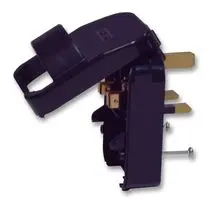Why would anyone want a bloody great hole through their worktop?
Because when one of these is fitted (see pic below) you have a cheap and simple way to avoid cutting off plugtops and thereby preserving the warranty on the appliance !
Also worthy of note is the fact that 'below-worktop' appliances (fridges freezers, washing washing machines etc) are, by domestic electrical design convention, supplied from a standard (unswitched) 13A socket outlet mounted in the wall to the rear of the appliance. This (unswitched) socket is generally configured as a spur from a fused/switched unit mounted above the worktop (in line with the socketoutlets above the worktop) which are there to supply small appliances (kettles, toasters etc).
In cases where the plug on a washing machine stops the appliance being pushed fully back against the wall (due to crap 1st and 2nd stage fix work placing the socket at the aperture midline), the answer is simple - relocate the socket to a position where the appliance plug top doesn't foul the rear of the appliance.






































